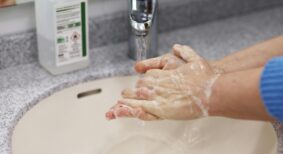Many owners and managers are looking into “workloading” as a solution for office cleaning. Introduced more than a decade ago and advocated by a leading janitorial consultant, David Frank, workloading has been adopted by many larger cleaning contractors servicing large facilities such as multi-storey office buildings.
Low building occupancy levels continue to be a concern for many throughout Canada and in most of the U.S. Office vacancies soared during the pandemic and have yet to come down, currently at 15.7 per cent in Canada, while nearing 20 per cent in the U.S. Further, instead of rushing back to the office after the pandemic, about half of all office workers decided they preferred to work at home, creating a sizable dilemma for building owners, managers, and the investors and bankers who have a financial interest in these properties.
RELATED: Commercial cleaning remains critical, even with lower building occupancy
Some facilities are being “rethought” and turned into apartments, hotels, and industrial facilities for more efficient use. However, many building owners and managers are holding the line, waiting it out with the belief that more former building users will eventually return to the office. In the interim, they are focused on effectively maintaining their facilities and, simultaneously, finding ways to reduce costs as much as possible. Historically, cleaning represents 20 to 35 per cent of a facility’s budget. While these percentages may have been altered with the pandemic, cleaning remains a big piece of the building budget, and it may present an opportunity for cost savings.
Today, more cleaning contractors, in-house cleaning workers, and building owners and managers are looking into or adopting workloading as part of their management strategy. The key benefits of workloading are clear: it can significantly reduce operating costs, enhance efficiency, and improve the appearance and health of facilities.
Defining the process
There is no universal definition of workloading, however, all the definitions point in the same direction. According to Frank, workloading answers the following questions:
How long does it take to complete a task or clean an area?
- How does changing task frequency affect cost and cleaning results?
- What happens to the bottom line when square footage is added or subtracted?
- What would a change in wages (due to adding more or fewer cleaning tasks, cleaning frequencies, or cleaning workers) for a facility’s overall budget?
These are questions some building owners and managers have never considered before, and they may be new to many cleaning contractors as well. A common assumption is that many cleaning contractors walk into a facility and still guesstimate from past experience what cleaning needs to be performed, how frequently, and what it will cost.
Workloading offers managers and owners the insight they need to benefit from higher efficiency, reduce costs, and better relationships. Here’s how:
- Efficiency increases when every cleaning task is documented and timed; cleaning crews avoid wasting time and ensure all areas are cleaned properly.
- Costs are reduced because when cleaning contractors have a data-based estimate of how much time and resources are needed to clean a facility, there is no wasted time or extra time spent to complete the job.
- Communication between clients and cleaning workers is enhanced when both parties are aware of exactly which tasks will be performed, when, and how long each one will take.
However, considering today’s difficult situation, guesstimating is no longer an option. Today, everything about cleaning must be data-driven.
How to begin
Starting the process means adding the right people to the team, so key stakeholders in the facility’s operation must be selected to participate. These people are typically building owners or managers, cleaning contractors, and distributors. Having distributors on board from the onset will guide the other stakeholders in determining which cleaning products, robots, tools, and cleaning methodologies are the highest-performing and most cost-effective. Further, if the facility wants green cleaning performed, the distributor will know precisely which products are best for the job.
Next, there are a few steps involved to begin workloading:
Cleaning the slate. This means a fresh start and a new approach to practices, products, and data. Forget about current cleaning procedures, the scope of cleaning work, and the number of cleaning workers now used to clean and maintain the facility. These will come to light once the data has been collected and the workloading procedure has been completed.
Scope of work. Scope of work is the formal document that outlines all the cleaning needs of a facility, the cleaning tasks that are to be performed, how often they are to be performed, what types of cleaning solutions, tools, and equipment are to be used, and quality requirements. Determine and divide all the cleaning tasks that need to be done into three categories: daily cleaning, interim cleaning, and project cleaning.
Taking inventory. Determine the total amount of cleanable space in the building. This is not gross square feet, it is cleanable square footage (space used by tenants for working) and it will likely be less today than it was just a few years ago. Often, the best way to do this is to review the building’s architectural drawings or, if necessary, measure all cleanable spaces in the facility for an accurate assessment.
Cleaning standards. This is the only subjective part of workloading and needs to be addressed at this juncture. In a post-pandemic world, standards have gone up and most managers are focused on thorough, hygienic cleaning. However, other facilities, such as warehouses or industrial locations, may be less concerned. The more concerned the customer is, the more time and energy is needed to maintain the facility.
Cleaning times. In the past, stakeholders referred to ISSA’s 612 Cleaning Times, developed by experts in the cleaning industry. This booklet reported, for instance, how long it should take to vacuum so many square feet of carpeting or mop so many feet of hard surface floor. Today, there are software programs that can help with these calculations for a simple and accurate look at the time required to complete assigned tasks.
Frequencies. Next, we assess how often each cleaning task should be performed. Frequency refers to the number of times a task needs to be performed per year. A task that is performed five nights per week, or 260 times per year, would fall into the daily cleaning category. Cleaning tasks that need just interim cleaning, possibly once per week, fall into interim cleaning and are usually performed 52 times per year. Project task frequencies are typically based on past experiences, such as how often carpets need deep cleaning.
Labour hours. Using our cleaning times and frequency data, we can now turn to a software program or an Excel spreadsheet to determine labour cost totals. Added to the labour costs, should be percentages paid for taxes, insurance, and employee benefits. Finally, as mentioned earlier, we must bring in our distributor to help us select the cleaning products needed to best complete the job.
Historically, some building owners and managers have viewed cleaning as a service, a needed commodity, assuming most cleaning services offer about the same value. That was never true, and that way of thinking has been tossed out the window with the pandemic in many cases.
Cleaning today must be based on data and proper workloading to improve efficiencies, reduce waste, increase revenues, and offer more value.
Michael Wilson is the CEO of AFFLINK, a distributor membership organization comprising nearly 300 distributors in North America. He has been with the organization since 2006 and provides strategic leadership for distributor members around the country. In his free time, Michael works with the Wounded Warrior Project, helping veterans heal and get their lives back on track.








